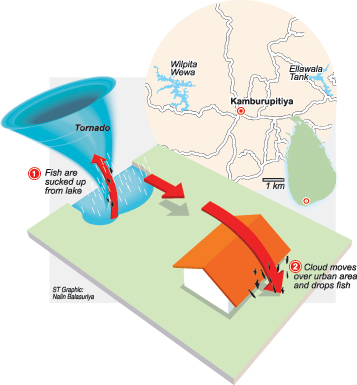News
Raining fish‘n’frogs instead of proverbial cats‘n’dogs
View(s):Not a sign of doomsday but a tornado/twister sucking aquatic life in its path of destruction and ditching them once powerless
By Malaka Rodrigo
Raining of fish is not a doomsday prophecy, but a normal meteorological phenomenon, experts assured.
‘Fish-rain’ was reported at least from two places in Embilipitiya and Kamburupitiya this week, while a prawn-rain was reported from Tissamaharama on Thursday, raising concern among residents.

The Ruhuna University Agriculture Faculty in Mapalana, Kamburupitiya, experienced ‘fish-rain’. On Monday, a number of small fish were found on the ground and on the roofs of the University’s office premises following a shower.
Officials of Ruhuna University’s Faculty of Fisheries, Marine Sciences & Technology on being informed, rushed to Mapalana to investigate the phenomenon. Faculty Head Ashoka Deepananda who had studied the ‘rain-fish’ and said the specimen he had checked were freshwater fish species Lula (Snake-head fish) and Hunga (Asian Stinging Catfish).
However, fish falling from the sky is not supernatural nor is it a doomsday prediction as some people made out, assures the expert.
Raining fish is a relatively common meteorological phenomenon, with occurrences reported on many instances in the past.
Tornadoes created by violently circulating winds, which suck things in its path, move across a body of water and suck the water into it, creating a water sprout. Fish and other organisms too could be sucked up in these water columns. They can then be carried away by the strong winds and come down to in another place, near or far, along with the rain, making it a ‘fish-rainfall’. If dropped close to its place of extraction, there is the possibility of the fish surviving.
No live fish were found by the Fisheries Faculty team, but Mr. Deepananda confirmed that the fish, though dead, were fresh, indicating that they had died a few hours before. He said the bodies of the fish were crushed and carried external wounds. Mr. Deepananda confirmed that fish samples on investigation showed that the fish had also suffered internal damage.
The expert told the Sunday Times that these kind of wounds are possible when the fish fall from a great height, or also at the time they are sucked into the water column – believed to be by a mini tornado that was experienceed in the area.
A small body of water called ‘Lenabatu wewa’ is located closer to the faculty, but Mr. Deepananda said the fish could have been extracted even from a small stream. Though only specimens of common freshwater fish in the area such as Lula and Magura were found, he believes there could be other fish species too among the species that were sucked up.

Kamburupitiya: “It’s raining fish”. Pic by Krishan Jeevaka Jayaruk
A few weeks ago, similar ‘fish-rain’ was also reported from Kantale. ‘Fish-rain’ was also reported from other parts of the world where even frogs and birds dropped with the rain that came about through the same phenomenon.
In certain instances where frogs fell with the rain, the animals seemed startled, though healthy, and exhibiting relatively normal behaviour, shortly after the event. It was also reported that, in other instances, the animals were frozen to death or completely enclosed in blocks of ice. These occurrences may be evidence of the thrust of the victims to very high altitudes, where the temperature is below zero, indicating how powerful meteorological forces can be.
Met. Dept Meteorologist Ananda Jayasinharachchi said that tornado-type phenomena are more common during the inter-monsoon period. This can create dense, towering, vertical cloud forming from water vapour carried by powerful upward air currents. The tip of these clouds can get close to land or water bodies, sucking organisms such as fish.
Experts point out that this kind of raining of animals could have occurred in the recent past too, but because people are alert and more observant these days, looking for signs of doomsday, they tend to see these and report.
Follow @timesonlinelk
comments powered by Disqus

















